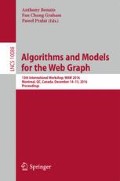Abstract
Modularity is designed to measure the strength of division of a network into clusters (known also as communities). Networks with high modularity have dense connections between the vertices within clusters but sparse connections between vertices of different clusters. As a result, modularity is often used in optimization methods for detecting community structure in networks, and so it is an important graph parameter from practical point of view. Unfortunately, many existing non-spatial models of complex networks do not generate graphs with high modularity; on the other hand, spatial models naturally create clusters. We investigate this phenomenon by considering a few examples from both sub-classes. We prove precise theoretical results for the classical model of random d-regular graphs as well as the preferential attachment model, and contrast these results with the ones for the spatial preferential attachment (SPA) model that is a model for complex networks in which vertices are embedded in a metric space, and each vertex has a sphere of influence whose size increases if the vertex gains an in-link, and otherwise decreases with time.
Access this chapter
Tax calculation will be finalised at checkout
Purchases are for personal use only
References
Aiello, W., Bonato, A., Cooper, C., Janssen, J., Prałat, P.: A spatial web graph model with local influence regions. Internet Math. 5, 175–196 (2009)
Albert, R., Barabási, A.-L.: Statistical mechanics of complex networks. Rev. Modern Phys. 74, 47–97 (2002)
Alon, N.: On the edge-expansion of graphs. Comb. Prob. Comput. 6, 145–152 (1997)
Bansal, S., Khandelwal, S., Meyers, L.A.: Exploring biological network structure with clustered random networks. BMC Bioinform. 10, 405 (2009)
Barabási, A.L., Albert, R.: Emergence of scaling in random networks. Science 286, 509–512 (1999)
Boccaletti, S., Latora, V., Moreno, Y., Chavez, M., Hwang, D.-U.: Complex networks: structure and dynamics. Phys. Rep. 424(45), 175–308 (2006)
Bollobás, B.: A probabilistic proof of an asymptotic formula for the number of labelled regular graphs. Eur. J. Combin. 1(4), 311–316 (1980)
Bollobás, B.: The isoperimetric number of random regular graphs. Eur. J. Comb. 9, 241–244 (1988)
Bollobás, B., Riordan, O.M.: Mathematical results on scale-free random graphs. In: From the Genome to the Internet, Handbook of Graphs and Networks, pp. 1–34 (2003)
Bollobás, B., Riordan, O.: The diameter of a scale-free random graph. Combinatorica 24, 5–34 (2004)
Bollobás, B., Riordan, O., Spencer, J., Tusnády, G.: The degree sequence of a scale-free random graph process. Random Struct. Algorithms 18, 279–290 (2001)
Borgs, C., Brautbar, M., Chayes, J., Khanna, S., Lucier, B.: The power of local information in social networks. In: Goldberg, P.W. (ed.) WINE 2012. LNCS, vol. 7695, pp. 406–419. Springer, Heidelberg (2012). doi:10.1007/978-3-642-35311-6_30
Cooper, C., Frieze, A., Prałat, P.: Some typical properties of the spatial preferred attachment model. Internet Math. 10, 27–47 (2014)
Fortunato, S.: Community detection in graphs. Phys. Rep. 486(3), 75–174 (2010)
Frieze, A., Pérez-Giménez, X., Prałat, P., Reiniger, B.: Perfect matchings and Hamiltonian cycles in the preferential attachment model (preprint)
Clauset, A., Newman, M.E.J., Moore, C.: Finding community structure in very large networks. Phys. Rev. E 70, 066111 (2004)
da Costa, L.F., Rodrigues, F.A., Travieso, G., Boas, P.R.U.: Characterization of complex networks: a survey of measurements. Adv. Phys. 56, 167–242 (2007)
Girvan, M., Newman, M.E.: Community structure in social and biological networks. Proc. Natl. Acad. Sci. 99(12), 7821–7826 (2002)
Janssen, J., Hurshman, M., Kalyaniwalla, N.: Model selection for social networks using graphlets. Internet Math. 8(4), 338–363 (2013)
Janssen, J., Prałat, P., Wilson, R.: Geometric graph properties of the spatial preferred attachment model. Adv. Appl. Math. 50, 243–267 (2013)
Janssen, J., Prałat, P., Wilson, R.: Non-uniform distribution of nodes in the spatial preferential attachment model. Internet Math. 12(1–2), 121–144 (2016)
Lancichinetti, A., Fortunato, S.: Limits of modularity maximization in community detection. Phys. Rev. E 84, 066122 (2011)
McDiarmid, C., Skerman, F.: Modularity in random regular graphs and lattices. Electron. Notes Discrete Math. 43, 431–437 (2013)
McDiarmid, C., Skerman, F.: Modularity of tree-like and random regular graphs (preprint)
Mihail, M., Papadimitriou, C., Saberi, A.: On certain connectivity properties of the internet topology. In: Proceedings of Conference on Foundations of Computer Science, pp. 28–35 (2003)
Montgolfier, F., Soto, M., Viennot, L.: Asymptotic modularity of some graph classes. In: Asano, T., Nakano, S., Okamoto, Y., Watanabe, O. (eds.) ISAAC 2011. LNCS, vol. 7074, pp. 435–444. Springer, Heidelberg (2011). doi:10.1007/978-3-642-25591-5_45
Newman, M.E.J.: Assortative mixing in networks. Phys. Rev. Lett. 89, 208701 (2002)
Newman, M.E.J.: Fast algorithm for detecting community structure in networks. Phys. Rev. E 69, 066133 (2004)
Newman, M.E.J.: Power laws, Pareto distributions and Zipf’s law. Contemp. Phys. 46(5), 323–351 (2005)
Newman, M.E.J.: The structure and function of complex networks. SIAM Rev. 45(2), 167–256 (2003)
Newman, M.E.J., Girvan, M.: Finding and evaluating community structure in networks. Phys. Rev. E 69, 026–113 (2004)
Pittel, B.: Note on the heights of random recursive trees and random \(m\)-ary search trees. Random Struct. Algorithms 5, 337–347 (1994)
Watts, D.J., Strogatz, S.H.: Collective dynamics of ‘small-world’ networks. Nature 393, 440–442 (1998)
Acknowledgements
This work is supported by Russian Science Foundation (grant number 16-11-10014), NSERC, The Tutte Institute for Mathematics and Computing, and Ryerson University.
Author information
Authors and Affiliations
Corresponding author
Editor information
Editors and Affiliations
Rights and permissions
Copyright information
© 2016 Springer International Publishing AG
About this paper
Cite this paper
Ostroumova Prokhorenkova, L., Prałat, P., Raigorodskii, A. (2016). Modularity of Complex Networks Models. In: Bonato, A., Graham, F., Prałat, P. (eds) Algorithms and Models for the Web Graph. WAW 2016. Lecture Notes in Computer Science(), vol 10088. Springer, Cham. https://doi.org/10.1007/978-3-319-49787-7_10
Download citation
DOI: https://doi.org/10.1007/978-3-319-49787-7_10
Published:
Publisher Name: Springer, Cham
Print ISBN: 978-3-319-49786-0
Online ISBN: 978-3-319-49787-7
eBook Packages: Computer ScienceComputer Science (R0)

